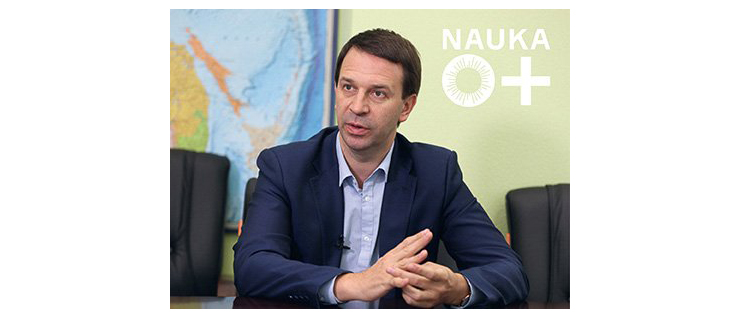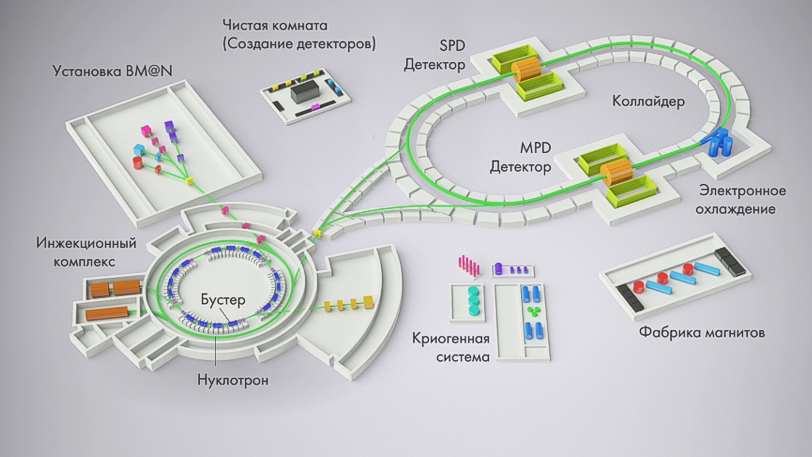Lecture “NICA mega-project: time machine in the Universe” at scientific festival
News, 12 October 2020
On 10 – 11 October, the Joint Institute for Nuclear Research took part in the All-Russian Festival “NAUKA0+”. The Joint Institute presented its stand at the central site in the Expocentre, Krasnaya Presnya, Moscow. In the frames of the Golden Lecture Hall, JINR First Vice-Director Grigory Trubnikov presented the lecture “NICA mega-project: a time machine in the Universe. Superdense nuclear matter, neutron stars and superconductivity for the services of humanity.”
Today, it seems to us that we know everything about how and from what our Universe emerged. How the physical world we are living in now was formed and how it works. However, not all scientists would agree with these statements. We still do not know much about the superdense hot point of the birth of the Universe, our infinitely large home, one of the rooms of which we live in. To understand it, it is necessary to trace the history of the Universe from its very first moments. How can we do this? We can experimentally restore everything that happened immediately after the Big Bang, to “roll the film back”, to recreate the conditions in which mysterious quarks and gluons were freely floating in the seething primaeval “soup”, at the moment when the world we observe today was born. Is it possible to recreate the conditions of the early Universe in the lab? First Vice-Director of the Joint Institute for Nuclear Research, Doctor of Physics and Mathematics, RAS Academician Grigory Trubnikov is sure that this can be made by the “time machine” called NICA.
The famous Large Hadron Collider constructed at CERN near Geneva is the largest experimental facility in the world. It was called large because of its size: the length of the major ring of the accelerator is 26,659 metres, and it was called hadron as far as its main task is to accelerate hadrons, i.e. protons and heavy nuclei. The word “collider” means that two beams of accelerated particles collide inside the ring in opposite directions in special places called particle detectors. In fact, the LHC is the first “time machine” designed to answer the questions about the birth of the Universe.
 From presentation by G. V. Trubnikov
From presentation by G. V. Trubnikov
However, there are tasks that even this giant machine cannot handle. The “sister” of the Large Hadron Collider the NICA facility (Nuclotron based Ion Collider fAcility) will take over them. It is a complex accelerating facility named after the ancient Greek goddess of victory Nica. The facility is under construction not far from Moscow, at the Joint Institute for Nuclear Research in Dubna. According to Grigory Trubnikov, NICA is one of those large-scale projects that now determine the future of physics. Scientists are sure that the accelerating complex will bring new knowledge about the structure of nuclear matter and will allow solving a wide range of applied tasks. Research centres of Russia and more than 20 countries of America, Europe, Asia and Africa take part in the implementation of the project.
What does cosmology tell us about the history of the Universe? First of all, the Universe is expanding. It was proved by Edwin Hubble, an outstanding astronomer and cosmologist after whom the famous telescope is named. Another important fact is that the Universe was not eternal. Experiments of recent years prove that it was born about 14 billion years ago. (By the way, our Sun is 4,6 billion years old, and the age of the Earth is 4,6-5 billion years).
Our compatriot, an astrophysicist Georgy Gamov proposed his own model of the birth of the Universe. He believed that it was originally extremely hot. The Universe from a point turned into a burning ball, and after that, first elementary particles began to emerge.
The size of the starting point of the Universe was 10-33 cm. The density of matter was 1094 grams per cm3. These figures are considered as boundary conditions overcoming which we will be able to look inside the Universe.
Why can a collider be called the time machine? Using extreme temperatures and phenomena, nuclei may decay into protons and neutrons. Scientists can observe in the lab how the tiniest particles gather in groups and form nuclear matter. Such a process happened during the birth of our Universe.
NICA is a heavy ion accelerator. Its main peculiarity is that it will operate right in the energy field that is not covered by any facilities operating in the world, including the Large Hadron Collider. Scientists will have a real chance to get a mixed phase of nuclear matter in which quarks and gluons released from nuclei as well as nuclei themselves may simultaneously exist. The creators of the accelerator will try to “catch” free quarks, which no one has done before. Scientists from Dubna will travel to the origins by the “time machine”. Nobody knows what is in store for us there. But it will definitely be something incredible.
Based on the materials of the portal “Scientific Russia”

